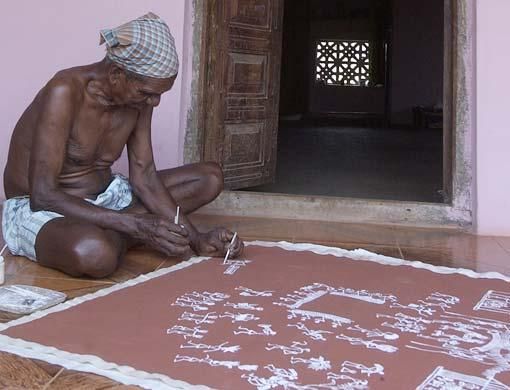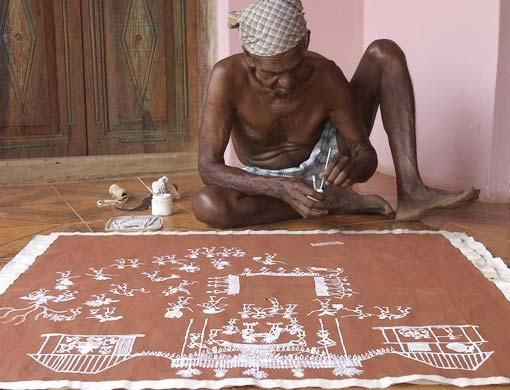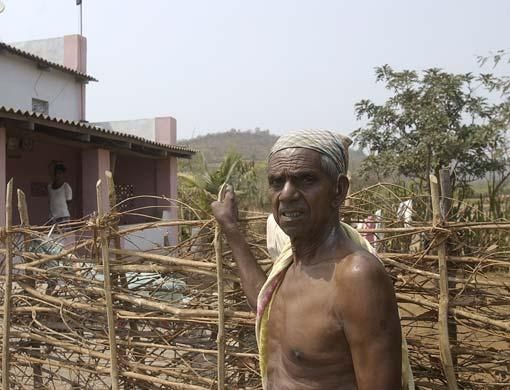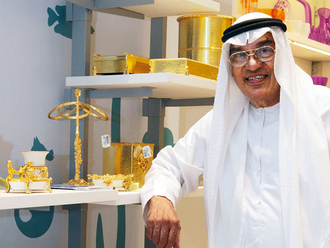Paris, Berlin, New York, London ... Jivha Soma Mashe, a member of a little known tribal community of Western India, has visited all these places either to accept awards for his brilliant works or to promote the little known tribal art called Warli paintings. Known as the MF Hussain of tribal art, he is worried that this art form may die out in a few years.
It is as if the world didn't exist.
Under a mandala of a million buzzing flies that hover over fish hanging out to dry on the roof of his dwelling, sits Jivha Soma Mashe, oblivious to the presence of visitors.
He is busy doing what he likes to do best - create works of tribal art.
The fierce heat of Kalamipada, 150 km from Mumbai, is enough to get the better of us despite the journey in an airconditioned car, but the bare-bodied gent with a kerchief tied around the head like a bandana seems unaffected, immersed as he is in his universe of geometric figures - triangles, squares, rectangles, circles, dots ...
Simple forms etched on canvas which tell stories of a once-rich rural area: the forest, mountains, birds, beasts, insects, flowing rivers, abundant crops; and of celebrations: music and dance, festivals and weddings; hunting, fishing and farming; the change of seasons ... of fertility and death.
It takes a while before he is able to sense our presence. One reason for that, it soon emerges, is that the elderly man is getting progressively deaf. Jivha waves us towards an old cot lying in the compound. It's actually a makeshift enclosure made of thorns to keep marauding animals out, so that he can give final touches to his work. So we move away from the man to admire his work from a distance.
While painting, he uses a white pigment made with a mixture of rice paste and water with gum as binding. A bamboo stick, its one end sharpened with a sickle, functions as a paintbrush.
It is easy to see myriad emotions registering on his face - happiness, triumph and, oh yes, pride - as he finishes the painting with deft strokes of the brush. It is a craft that requires attention to minute details and therefore excellent eyesight.
The masterpiece done - a portrait of a Warli wedding ceremony - he retrieves an almost stubbed out beedi, the Indian version of a cigarette, from an ancient ashtray beside him and motions us to come closer to him so that he can hear us.
Jivha, like most people of his tribe, speaks an odd dialect, which is a mixture of Marathi, Hindi, Gujarati and Sanskrit. Therefore the services of a local translator are necessary. He wants to know if we are officials from the government wanting to fete him for his work ... perhaps to present him with a state award? Not that he is hungry for attention. The wall above his head is crammed with faded photographs showing him being felicitated by the likes of Indira Gandhi, Rajiv Gandhi and Sonia Gandhi and former Presidents Fakhruddin Ali Ahmed and APJ Abdul Kalam.
He is happy to learn that he is being interviewed for an overseas publication.
Jivha cannot read or write save for his name, which he manages to inscribe at the bottom of his portraits, but he is able to connect instantly with the word 'foreign' which he pronounces as 'phoreen' in his rural Maharashtrian patois.
Foreign, in his case, means travelling in an aircraft to far away places with names he has now become so familiar with - New York, Washington, London, Paris, Berlin, Rome, Tokyo, Toronto, Moscow....
That he has seen them all, not to mention the fact that he is the most outstanding practitioner of his art with shows in many major galleries and museums (many regard him as the M F Husain of Indian tribal painting) makes him a legendary figure in the small Warli community living in Western India.
But it wasn't always like this. Long before the forests in the area around Mumbai were consumed by modern development, Warli ritual paintings were confined to tribal homes. They were usually rudimentary pictographs done on the walls of huts made of a mixture of leaves, branches, earth and cow dung on certain occasions like harvest, childbirth, festivals ... The paintings were mostly the preserve of women folk.
In the early 1970s, Jivya Soma Mashe was the first to cut free from the canons of Warli artistic tradition. He didn't offer the former alibi of a ceremony to paint, but began to do it "just like that" on a daily basis.
Soon enough his talent was noticed by doyens of art like Pupul Jayakar, who displayed his craft at New Delhi. Then came recognition, at national and international levels.
He got the best artist award from the Indian government in 1976. Mumbai's Gallery Chemould facilitated a special display of Jivha's work at the 1976 Biennale de Menton, and in 1987 organised an exhibition of Warli painting at the Horizon Gallery, London. Then followed invitations to participate at acclaimed exhibitions like Magicians of the Earth in Paris in 1989.
Since then he has emerged as a beacon of inspiration for youngsters in his community, some of whom have even trained under him in makeshift workshops or those organised by the government.
There is nothing complex about his work - it's appeal lies in it being refreshingly direct and based on simple forms: circles, representing the moon or the sun, triangles, for mountains and trees - two of them to signify human bodies ... The paintings are rich with people and movement.
Jivha doesn't have much to say about his past, he doesn't even know how old he is. His son Baalu, also a painter in his tradition, helps us. My father must be around 74 he says. Jivha remains fit from years of trudging through the fields on foot. He used to trudge close to 20 km every day to work on the fields owned by a local money lender.
He doesn't have to do that anymore. With the money he earned from his paintings he has now purchased land for cultivation. Nine acres of earth belong to him and it is easy to detect the pride in his eyes. Thanks to his art the local administration has now deemed it fit to construct a good road leading to his house in Kalamipada - it is the biggest there. But there was a time in his past when for many years home was cowshed and a solid roof over the head was a dream.
Abandoned by his family as a very young boy, his only companion for many years was silence. Then at 10 he began drawing on the ground finding inspiration from nature - the green of the forest around him, an abundance of water bodies (alas now disappeared), visions of dark clouds and rain cascading down to earth, dancing peacocks, fruit ripe for picking, palm trees curled into angry apostrophes in the blowing wind, jungle trails and the Mahalakshmi Hill - "just across the fields".
Actually the hill, the setting for an annual fair, is at a distance of about 10 kms, a craggy rock rising out of the earth like a giant thumb bent backwards, a hunter, as it were, in the final stages of releasing an arrow from a bowstring.
For what now seems like aeons the hill has inspired Jivha and generations of Warli tribals living in the umbra of the Sahyadri Mountains along Maharashtra's border with Gujarat.
Understandably it forms the backdrop in many of his paintings.
Jivha soon extended his wall painting skills to other non traditional surfaces like paper and canvas. His free and candid style gave off its very own sensibility. Walking, shown in the form of figures moving on a single track or multiple lines, is a constant in his paintings, and is reminiscent of images depicted by Alberto Giacometti or Jacques Tati. The emphasis always is on movement which is in complete harmony with nature.
The pastoral stories and legends are fully fleshed out on canvas and describes the feeling of roots which drives the Warli soul. It conjures up images of ancient times and an ancestral culture and provide an indepth insight into the cultural and religious foundations of modern India. But they look best on walls or murals.
Till 25 years ago, the Warlis could never have imagined commercialising art, but times have changed. With the loss of much of the old forests and fields many have been forced to adopt modern lifestyles, do odd jobs in factories in nearby towns and cities.
Jivha has come a long way from being invited to paint on walls of homes during weddings, that too for gratis, to reproducing his art on paper or canvas for both domestic and overseas clients. Since he completes a painting in about three days, the orders continue to flow. The rates vary from Rs2,000 for a small portrait to Rs50,000 for a fairly large-sized creation.
It is not as if Jivha is commerce-minded but he has seen much of the modern world and is not exactly averse to a few comforts that wealth brings along with it. He is, for instance, happy showing off the dish antenna that brings to life the colour television set in his home, and the refrigerator which keeps water cool. "We have to respect money," he says.
The man's mission in life now is to promote Warli painting - there is the fear that the art will be lost to succeeding generations. Six months ago he organised a workshop on Warli painting. "About 15-16 youngsters, both boy and girls, attended. That is a very encouraging sign but most people nowadays are just not interested. It is a dying tradition and there is not much (government) support. There is no school to teach this," says Jivha, wryly.
Indeed the world has changed dramatically for the tribal painter from Kalamipada. He is a contented man but there is also a sense of loss which he cannot adequately describe in words. "It used to be nice before," says the artist with a faraway look, longing perhaps for the ruralia which has now gone missing.
In a short while from now Jivha will make his way to the annual fair at the bottom of Mahalakshmi Hill in the distance - there is a painting to be done there.















